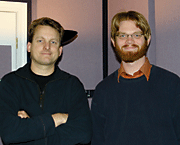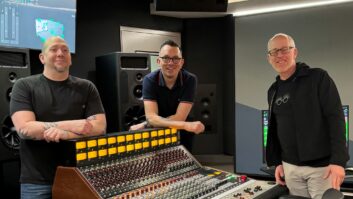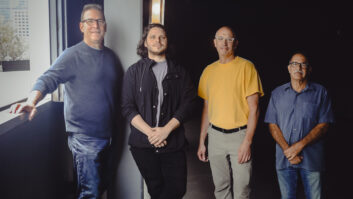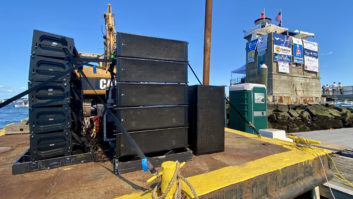

During the past several years, Marin County-based Bay Area Sound has quietly grown to become one of the leading independent game sound facilities in Northern California, contributing to a wide variety of projects by leading and smaller companies, and bringing work to a talented coterie of outside sound and dialog editors, composers and others. Though the entity known as Bay Area Sound (www.basound.com) has been around since 2000, the roots of its principals, Julian Kwasneski and Jared Emerson-Johnson, go back much further.
Principals Julian Kwasneski (arms folded) and Jared Emerson-Johnson
Audio director Kwasneski got into game audio through a slightly unorthodox route. Though he was a musician from a young age and a serious gamer since the era of Pong and the first Atari systems, his first job out of school was as a stock broker for Merrill Lynch. “I did that for two years and I was miserable,” he says. “I got in touch with Mooka Rennick of Prairie Sun [Studios, in Cotati, Calif.], quit Merrill Lynch and started waiting tables and bartending in Calistoga while working for basically nothing at Mooka’s studio. I’d clean multitrack heads and align tape decks and get coffee for people. I loved it!”
Then, after a cousin got a job at George Lucas’ Industrial Light & Magic, Kwasneski landed in the voice department of another company affiliated with the filmmaker: LucasArts Entertainment, whose principal raison d’etre seemed to be to turn out an unending stream of Star Wars-based videogames. “It was immediately apparent I’d stumbled into something very cool,” he says. After a year as a dialog editor, he moved into other sound editorial positions. “I worked on every project LucasArts did from ’95 to 2000,” he says. “It was a tremendous learning experience. We worked out some great production systems at LucasArts — they were really trying to advance the state of the art [in game audio] there.
“We started doing Foley, and we would score the noninteractive portions of the game as if they were little films; all the while, I was working with other friends of mine who were at ILM making their own independent films,” Kwasneski continues. “It was the beginning of digital audio [in game post], and we were doing live music recordings and starting to cast big-name actors, and we really pushed that side of it. By about ’98, we really started to take it to the next level.”
Eventually, however, he got restless and wanted a change of pace. That change came in the form of a dot-com called Ibeam Broadcasting, which was a sort of precursor to YouTube, but evidently ahead of its time: “It crashed and burned,” he says. From there, Kwasneski joined forces with another former LucasArts game audio employee — Clint Bajakian — in a company initially called CB Studios, then The Sound Department and finally Bay Area Sound. Bajakian left in 2003 to work for Sony’s game division.
At that point, Emerson-Johnson came onboard. He has a music degree from Cornell and a background in classical composition, conducting, violin and other aspects of music. More than just the primary composer in the company, Emerson-Johnson is also now an experienced sound designer, recordist and editor. Together, they’ve worked on such titles as Sam & Max (Season One); Alien Syndrome; CSI: 3 Dimensions of Murder; Bone: The Great Cow Race and Out From Boneville; The Chronicles of Narnia: The Lion, the Witch and the Wardrobe; God of War; Star Wars: Knights of the Old Republic — The Sith Lords, Republic Commando and Apprentice to the Force; Psychonauts; James Bond 007: Everything or Nothing; The Lord of the Rings: The Return of the King; Rise to Honor; Indiana Jones and the Emperor’s Tomb; The Bard’s Tale; and Mercenaries.
“Right now,” Kwasneski says, “I’m working on a very intense Conan game [with Nihilistic and THQ] that has a lot of hand-to-hand combat and a lot of rich ambiences — really colorful creatures. There are so many things in it that if you looked at it and you spotted everything that could make sound, you’d never finish and it wouldn’t be right if you did score it all — it would be a cacophony of crap. In this job, you have to make the call as to what’s going to serve the player and the game experience the most. Hearing that little cloth rustle probably isn’t it, but hearing these killer swishes and these big tips of the weapons and the menacing roars — that’s important. On a basic level [as a player], you want to feel like you’re interacting with the world, so you do what needs to be done.”
Bay Area Sound emphasizes original recording for games rather than relying on libraries “because you not only get the thing you’re recording perfect, but you can also try to get the space it’s in,” Kwasneski says. “If you’re recording something that occurs 15 virtual feet from the virtual camera [the game’s POV], you record it that way if you can; you don’t record it really close and then process it to sound like it’s 15 feet away.”
Kwasneski also emphasizes that building in variety and a certain randomness helps make the game more interesting, so he likes to provide as much material as possible. He sings the praises of development tool FMOD, a cross-platform audio engine he describes as “the go-between between programmers and game developers and the sound guys. So, for example, if [an in-game instruction] says, ‘dude kicks in door,’ there’s a sound tag for that and then, unbeknownst to the player, what happens when ‘dude kicks door’ is [activated] in the game. We have all this level of intricacy and variation and we don’t have to say to the programmer, ‘Okay, I want you to pick one of six of these, mix that with one of 10 of these, take this and pitch it down a little and vary the pitch a bit each time it happens.’” Instead, it is built into the game engine.
“Anything we’ve done recently, if you go up and kick a door in and then you quit the level and then go back and kick it again, I don’t want it to ever sound the same, so we put enough different layers in that your possibilities are close to infinite.” FMOD supports 13 different platforms, including Xbox 360, PlayStation 3 and Wii. Kwasneski notes that the increased bandwidth available to audio in the newer formats means that he’s no longer having to deal as much with down-sampling of effects and/or music “There’s no converting to 22k now; it’s all 44/16 or 48/18. The bandwidth benefits everyone, including the visual people: ‘Ooh, we can do this many pixels now,’ and, ‘The frame rate is 1,000 fps.’ You don’t have to think about whether you can do something now. You’re just limited by your programming resources and your creativity with it.”
Bay Area Sound is equipped with a Pro Tools HD2 and several LE rigs, G5s and multiple Genelec 1030A monitors, and has a vocal booth, but Kwasneski also uses a number of regional studios. “If I need to do a full dialog session, we’ll hire a studio that’s set up for it, and I’ll go there and direct them,” he says.
When Kwasneski and I spoke, he and Emerson-Johnson were busy doing production on Episode 5 of the ongoing Sam & Max online series, as well as working on a few longer-term projects. “Working on Sam & Max is almost like working on a TV series,” Kwasneski says, “because it’s quite time-consuming, it’s a very tight schedule and new ones keep coming up. We’re constantly improving it. Jared did an extensive jazz score in which he hired a lot of live players, and it has been very well-received by the fans. Despite the fact that the games are downloadable titles — which can sometimes mean limited bandwidth — we use pro voice talent, record most of our own sounds and produce live music scores.”
Talking to Kwasneski, one gets the sense that he loves every aspect of his job — that recording dialog for the ultra-realistic CSI games is as fun and challenging as working on sound for the cinematics of the Chronicles of Narnia game. He had just completed work on a fanciful title called Alien Syndrome — an update of a crude 1987 Sega arcade game — and there were other titles waiting for him and Emerson-Johnson to dive into.
“I think that rather than me choosing game audio, game audio chose me,” he says, “because I always loved games and I always paid attention to the sound, but it seemed like one of those untouchable things. And then all of a sudden there I was doing it and working 100-hour weeks. Now we’ve got our business and it’s a little more manageable, but it’s doing something I really love and care about.”
Blair Jackson is a senior editor at Mix.

For additional Sam & Max audio clips, visit www.telltalegames.com/samandmax/soundtracks
For more audio clips for Bone, visit www.telltalegames.com/bone/soundtracks.







